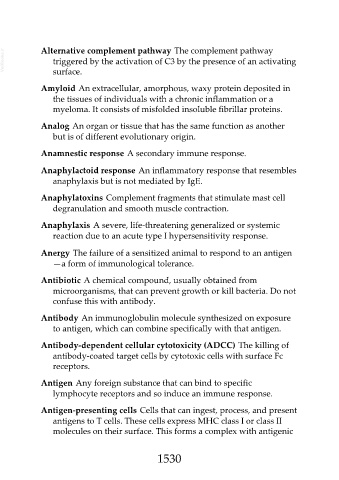Page 1530 - Veterinary Immunology, 10th Edition
P. 1530
VetBooks.ir Alternative complement pathway The complement pathway
triggered by the activation of C3 by the presence of an activating
surface.
Amyloid An extracellular, amorphous, waxy protein deposited in
the tissues of individuals with a chronic inflammation or a
myeloma. It consists of misfolded insoluble fibrillar proteins.
Analog An organ or tissue that has the same function as another
but is of different evolutionary origin.
Anamnestic response A secondary immune response.
Anaphylactoid response An inflammatory response that resembles
anaphylaxis but is not mediated by IgE.
Anaphylatoxins Complement fragments that stimulate mast cell
degranulation and smooth muscle contraction.
Anaphylaxis A severe, life-threatening generalized or systemic
reaction due to an acute type I hypersensitivity response.
Anergy The failure of a sensitized animal to respond to an antigen
—a form of immunological tolerance.
Antibiotic A chemical compound, usually obtained from
microorganisms, that can prevent growth or kill bacteria. Do not
confuse this with antibody.
Antibody An immunoglobulin molecule synthesized on exposure
to antigen, which can combine specifically with that antigen.
Antibody-dependent cellular cytotoxicity (ADCC) The killing of
antibody-coated target cells by cytotoxic cells with surface Fc
receptors.
Antigen Any foreign substance that can bind to specific
lymphocyte receptors and so induce an immune response.
Antigen-presenting cells Cells that can ingest, process, and present
antigens to T cells. These cells express MHC class I or class II
molecules on their surface. This forms a complex with antigenic
1530

